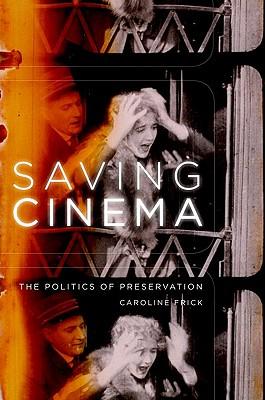
'Saving Cinema- The Politics of Preservation' By Caroline Frick ,
Oxford:
Oxford
University
Press, 2011.
ISBN 978 0 19 536811 6 215pp. (softcover) £17.99
It is a lamentable fact that the necessity to keep things- in this case
movies- is a relatively new concept, and certainly one which has not
involved all parties for all of the time. True, archives like the
Cinematheque Francaise (under the auspices of Henri Langlois) have been
around for many years, but even they have fallen victim to others
holding opposing views (in this case the occupying German authorities).
Of the major studios, the realisation that they are curators of not
just potential DVD releases but a national- and international- heritage
is a far more recent phenomenon. Indeed, Caroline Frick opens her book Saving
Cinema-
The Politics of Preservation with an account of the 1990
Universal Studios fire, highlighting as it does the attitude to loss,
and potential loss.
It is highly ironic that the book should begin with a fire, for the
aftermath of such an inferno is exactly what reading the contents
becomes. In short, one can see where one is supposed to be looking (and
has a hazy idea of what at), but the surrounding mist/ smoke makes
visualisation difficult. Frick’s book is divided into six chapters,
including such approachable titles as ‘International Discourse and
Global Film Heritage: Defending the National’, and is the literary
equivalent of wading through treacle- there is barely a sense of
progress, and what progress there is remains slow. One of the key
problems is that the arguments made are virtually always made without
specific film examples to underpin what is being said. For example,
that Warner Brothers ‘effectively utilized its older titles prior to
the advent of television, if primarily for marketing purposes, public
relations and nostalgia tributes’ (p. 67) is fair enough, but not to
mention any particular films in this paragraph lessens the impact and
makes the text dry and undynamic.
Another problem with Frick’s book is the hugely unnecessary use of
acronyms. Between two pages (pp. 95-96), for instance, we are
introduced to UNESCO, ICIC, IECI, the BFI and CAME. True, UNESCO and
the BFI should not be unfamiliar, but this is indicative of the desire
to continually namecheck organisations- the result being, again, a
clouding of the overall picture. Despite these foibles, Saving
Cinema does make some valid points, not least about the potential
advantages of modern society in two key respects. Firstly, the ability
to make lossless copies of material is a decided plus- the risk
of a specific title being lost becoming increasingly minimised.
Secondly, the democratisation of the Internet means that access is,
theoretically, less restricted than before- ‘in the digital age,
perhaps widespread, bountiful access is, itself, preservation’ (p.
153).
Overall, Saving Cinema- The Politics of Preservation is a
worthy (but dull) attempt to provide an account of conservation and
preservation methods. The areas the book invites the reader to discover
are largely necessary ones, but its density acts as a hefty barrier to
doing so.
'Saving Cinema- The Politcs of Preservation' is published by Oxford
University Press.
Oxford University Press
website
Back
Home

